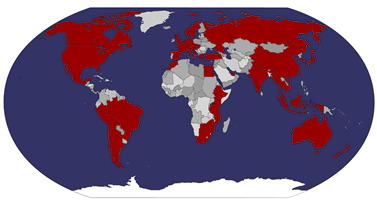
For me, a more conservative scrambled eggs on toast, and a tuna salad (need green stuff!).
Ladakhi language, spoken in Leh, is a form of Tibetan, apparently (according to those I spoke to) not understood mere miles way! Apparently the spelling is the same as Tibetan but they pronounce differently.
We walk into town, passing a travel agent running daily trips to Pangong Tso. We pop in, and I like Mahen, the chap running it – he’s from Sikkim but spends his time between here, Nepal and there. We book for the 26th – a daytrip. It’s a long ride – 5 ½ hours there and a bit less coming back. We need permits, and for that we need to give him photocopies of our passports and visa page. It’s just like the Sikkim permits, except here you’re no longer allowed to apply directly to the District Magistrate yourself, you need to pay an agent for the privilege.
We do our laundry at Dzomsa, the eco-friendly shop where they wash your clothes in good detergents and don’t dump chemicals into the drains etc. The also refill mineral water bottles for free and do lots of other good things.

Back at the post office, we send off the first batch of postcards. It’s amusing to watch half a dozen foreigners all sat around a pot of glue, beavering away. You see Indian stamps are not sticky at all. I think they’re supposed to be, but there’s no way the substandard glue would survive international post, so you have to stick them on yourself.

In the other office, where the chaps sit, there is an enormous stack of postcards ready to go. I suspect it is most of their job, banging the black stamp on the cards one by one.

Prayer wheels
In the market, we buy sunglasses from a Punjabi chap. I appear to have lost mine, and Thuzar didn’t have any anyway. I’m a bit annoyed about this really – where did I leave them? They weren’t expensive, from Boots I think, but I had grown rather attached. Anyway, new ones are a bit rubbish, but they’ll do the job.

Down at the bus station, we try to book the bus to Manali, i.e. to leave Leh, for the 27th.
I find the booking office in the building at the side of the station. The booths are empty, but an unmarked room down the corridor has activity. The chap tells me come back the day before we want to travel. Well, I’d prefer to book now please, as I’m here already. No, I can’t book now – look at his reservations book, no one else has booked for that day. So why can’t we be the first. Nope, come back the day before. I walk away resolving to find an alternative mode of transport.
Today is “Sights of Leh” Day!

First up, the Jama Masjid (Mosque), at the top of Main Bazaar Street. It’s a white building decorated with floral patterns.

I’m not sure we’re allowed in, so we turn right and head into the Old Town, intending to make up a route up to Leh Palace above us.

Leh Old Town is a crowded den of buildings made of mud, alleyways with putrid drains running down their side, beautiful large sunflowers poking over walls or out of window boxes. It’s hot and dry. Another foreign couple are walking up at the same time as us – we pause to let each other take the same photos! One can take any number of routes up, but as long as you keep going up, you end up at the Leh Palace.

Leh Palace towers above Leh. In front we bump into Katja, our Russian friend, so we go in together. There’s no obvious ticket booth, so we walk in, and start climbing in the dark unlit interior. There’s a small temple where a lone monk chants.

There are obviously extensive renovations occurring – some floors have lots of food and wood-shavings lying about. We come across several workmen, one of whom charges us the 100r fee. I’m a bit suspicious, but he produces some tickets from his pocket.

There are a few faded murals to see, but the real treat is up on top of the palace, where one has a marvellous view over all of Leh.

Some of the floors require scaling of wobbly ladders to ascend, but it’s worth it.

Of course, the only better view than here is going to the Namgyal Tsemo Gompa, the building perched even higher above us. So after coming out of the Palace, we start on the path to walk up there. Katja doesn’t fancy joining us for this. We plod up slowly, passing people on the way down who all give us encouragement.

It’s a slippery unmade path, with lots of loose scree. There’s a very long line of prayer flags stretching across above us.

At the top there are several small buildings all of which seem deserted.

It’s clear across to the Stok range.

The closed up gompa is open when we head downstairs.

Interlude: Ladakhi Population Control
Living in a place with such limited resources meant Ladakhis adopted customs which kept the population stable and prevented fragmentation of family land. Thus the eldest son inherited all land, at least one son became a monk, and the remainder could do what they want, or to enter into a polyandrous marriage with the eldest brother’s wife. The question of who the genetic father was was considered irrelevant. The head of the household was “big father” and the other brothers, “little father”. These practices were made illegal in the 1940s, and now rural communities have increasing difficulties sustaining themselves.

Back down in town, we stop for a bite and a drink at the Mountain view restaurant. Initially we sit in the sun, but after being toasted for a few minutes, move under the shade of the canopy.

Thuzar has momos, and I have a tuna sandwich, though near the end of it I find a few blue specks in the bread. Mould. Great.

The chap assures me the bread is fresh each day. That may be, but there’s mould in it.

We pop into the Ladag Apricot Store and buy dried apricots for Engineer, as he’s invited us round for tea to his house. Here they also have Sea Buckthorn juice, the latest healthy drink craze, full of vitamin C etc, which we try. I like it!

Via our hotel we head up to the large Japanese Peace Pagoda, Shanti Stupa, above town. It’s not far from us, at the end of Changspa. It’s a brisk 15 minute climb, starting with a small temple gate, then steps, 554 to be exact. We take it slow, and periodically stop to “enjoy the scenery” (huff huff huff).

At the top, the stupa is enormous and nicely decorated, and the view over Leh is marvellous.

It’s still bright, so I circle the stupa, enjoying the frescoes and patterns.



Om Mani Padme Hum
This is the great mantra of Avalokiteshvara, the bodhisattva of compassion, and is the most well-known Buddhist chant. What does it mean? Om is the auspicious syllable which precedes most mantras, mani means jewel in Sanskrit and padme means lotus. Hum has no literal meaning but may infer “holding”, and rhythmically ends the mantra. Buddhist prayers do not call on Gods or outside forces for help, instead reminding people of the power within themselves, which can be used when freed from selfish desires.


“Above all do not lose your desire to walk. Every day I walk myself into a state of well-being and walk away from every illness. I have walked myself into my best thoughts and know of no thought so burdensome that one cannot walk away from it.” - The Buddha.


There’s a monk doing the same, so we say hello to him. He’s from the Nubra Valley, not far away, over the Khardung La, the world’s highest road allegedly.

We also meet a Korean girl we saw yesterday at the restaurant, called Aram (no G!).

After chatting for a while, we start to head down, thinking the sunset was effectively over.

How wrong! Seconds later the sky turns an incredible shade of orange red as the sun dies a slow glorious death.

Wisps of cloud light up in front of the deep blue mountainous backdrop.


Next we walk to Engineer Lasso’s house, but he’s not there. We give his wife the apricots and promise to return the next morning. Shot cutting back in the dark, Thuzar discovers that she’s lost the sunglasses that we bought hours before! I insist we go back to look, using my cameras IR focus beam to help us. Back near Engineer’s house, we bump into him, but carry on the search. We don’t find them, and back near our hotel eat at Café Jeevan.
Ladakhi staple food is roasted barley flour called tsampa. The raw barley is roasted in hot sand (to prevent it from burning) until it pops. It is then separated from the sand and ground to a fine flower. This can be mixed with tea, put into soup or made into porridge.
Before retiring, I try to use the internet, but it’s torture. First the chap gives me a duplicate IP address, then for a while I assume it isn’t working because of configuration. Wrong, its just so slow. It would seem that everyone in town uses the same single satellite link.




No comments:
Post a Comment